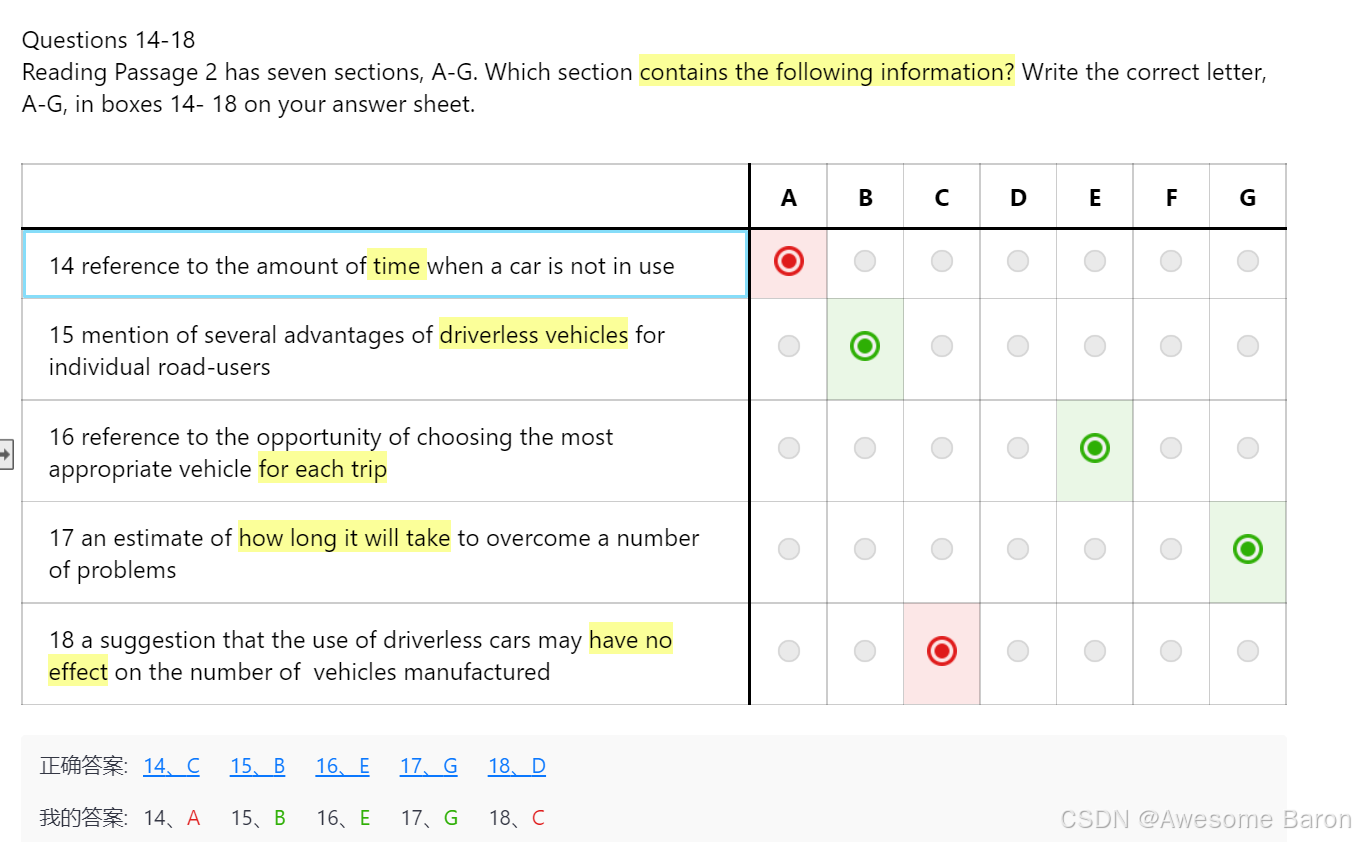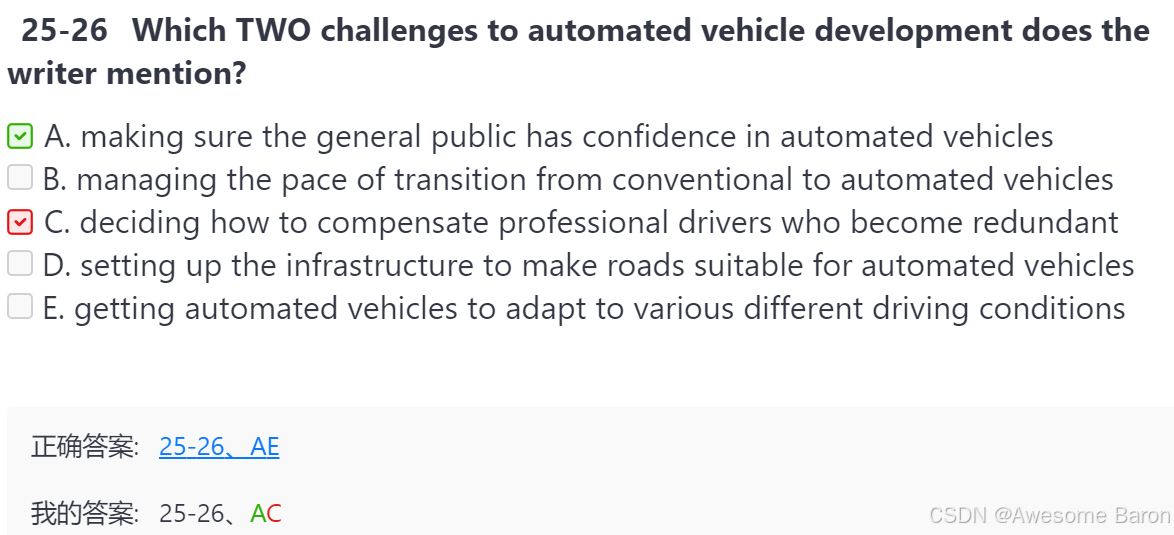IELTS 阅读C15-test1-passage 2 复盘
原文
Driverless cars
A The automotive sector is well used to adapting to automation in manufacturing. The implementation of robotic car manufacture from the 1970s onwards led to significant cost savings and improvements in the reliability and flexibility of vehicle mass production. A new challenge to vehicle production is now on the horizon and, again, it comes from automation. However, this time it is not to do with the manufacturing process, but with the vehicles themselves.
Research projects on vehicle automation are not new. Vehicles with limited self-driving capabilities have been around for more than 50 years , resulting in significant contributions towards driver assistance systems. But since Google announced in 2010 that it had been trialling self-driving cars on the streets of California, progress in this field has quickly gathered pace.
B There are many reasons why technology is advancing so fast. One frequently cited motive is safety; indeed, research at the UKs Transport Research Laboratory has demonstrated that more than 90 percent of road collisions involve human error as a contributory factor, and it is the primary cause in the vast majority. Automation may help to reduce the incidence of this.
Another aim is to free the time people spend driving for other purposes. If the vehicle can do some or all of the driving, it may be possible to be productive, to socialise or simply to relax while automation systems have responsibility for safe control of the vehicle. If the vehicle can do the driving, those who are challenged by existing mobility models - such as older or disabled travellers - may be able to enjoy significantly greater travel autonomy.
C Beyond these direct benefits, we can consider the wider implications for transport and society, and how manufacturing processes might need to respond as a result. At present, the average car spends more than 90 percent of its life parked. Automation means that initiatives for car-sharing become much more viable, particularly in urban areas with significant travel demand. If a significant proportion of the population choose to use shared automated vehicles, mobility demand can be met by far fewer vehicles.
D The Massachusetts Institute of Technology investigated automated mobility in Singapore, finding that fewer than 30 percent of the vehicles currently used would be required if fully automated car sharing could be implemented. If this is the case, it might mean that we need to manufacture far fewer vehicles to meet demand.
However, the number of trips being taken would probably increase, partly because empty vehicles would have to be moved from one customer to the next. Modelling work by the University of Michigan Transportation Research Institute suggests automated vehicles might reduce vehicle ownership by 43 percent, but that vehicles average annual mileage would double as a result. As a consequence, each vehicle would be used more intensively, and might need replacing sooner. This faster rate of turnover may mean that vehicle production will not necessarily decrease.
E Automation may prompt other changes in vehicle manufacture. If we move to a model where consumers are tending not to own a single vehicle but to purchase access to a range of vehicles through a mobility provider, drivers will have the freedom to select one that best suits their needs for a particular journey, rather than making a compromise across all their requirements. Since, for most of the time, most of the seats in most cars are unoccupied, this may boost production of a smaller, more efficient range of vehicles that suit the needs of individuals. Specialised vehicles may then be available for exceptional journeys, such as going on a family camping trip or helping a son or daughter move to university.
F There are a number of hurdles to overcome in delivering automated vehicles to our roads. These include the technical difficulties in ensuring that the vehicle works reliably in the infinite range of traffic, weather and road situations it might encounter; the regulatory challenges in understanding how liability and enforcement might change when drivers are no longer essential for vehicle operation; and the societal changes that may be required for communities to trust and accept automated vehicles as being a valuable part of the mobility landscape.
G It’s clear that there are many challenges that need to be addressed but, through robust and targeted research, these can most probably be conquered within the next 10 years. Mobility will change in such potentially significant ways and in association with so many other technological developments, such as telepresence and virtual reality, that it is hard to make concrete predictions about the future. However, one thing is certain: change is coming, and the need to be flexible in response to this will be vital for those involved in manufacturing the vehicles that will deliver future mobility.
题目1
这样一道题目:

总结
Which section contains the following information?
所以这道题目问的是哪一段包含了问题所说的,而不是对文章各段落总结。
做题的步骤应该是:
- 读题目和问题内容。
- 定位问题涉及的关键字。
- 浏览文章每段,寻找含有这些关键字或与之相关的信息的段落。
- 选出正确的段落。
复盘答案
14题:14 reference to the amount of time when a car is not in use
由amount of time和not in use定位到C部分,more than 90 percent of its life对应amount of time,parked对应not in use,故选C。
对应原文:C部分第1段:At present, the average car spends more than 90 percent of its life parked.
15题:15 mention of several advantages of driverless vehicles for individual road-users
由advantages和individual road-users定位到B部分,该部分提到无人驾驶有安全性,能把人们花在开车上的时间腾出来,让残疾人和老人有更多的自主出行,故选B。
对应原文:B部分:One frequently cited motive is safety … Another aim is to free the time people spend driving for other purposes … those who are challenged by existing mobility models may be able to enjoy significantly greater travel autonomy.
16题:16 reference to the opportunity of choosing the most appropriate vehicle for each trip
由most appropriate定位到E部分的best suits,freedom对应opportunity,select对应choosing,a particular journey对应each trip,故选E。
对应原文:E部分第1段:drivers will have the freedom to select one that best suits their needs for a particular journey
17题:17 an estimate of how long it will take to overcome a number of problems
由problems定位到G部分的challenges,be conquered对应overcome,within the next 10 years对应how long,故选G。
对应原文:G部分:It’s clear that there are many challenges that need to be addressed but … these can most probably be conquered within the next 10 years.
18题:18 a suggestion that the use of driverless cars may have no effect on the number of vehicles manufactured
即无人驾驶汽车的使用可能对车辆生产数量没有影响
18、由number of vehicles manufactured定位到D部分的vehicle production,will not necessarily decrease对应have no effect on,故选D。
对应原文:D部分第2段:This faster rate of turnover may mean that vehicle production will not necessarily decrease.
题目2

总结
对应原文F段:
F There are a number of hurdles to overcome in delivering automated vehicles to our roads.
These include the technical difficulties in ensuring that the vehicle works reliably in the infinite range of traffic, weather and road situations it might encounter;
the regulatory challenges in understanding how liability and enforcement might change when drivers are no longer essential for vehicle operation;
and the societal changes that may be required for communities to trust and accept automated vehicles as being a valuable part of the mobility landscape.
C. deciding how to compensate professional drivers who become redundant这里判断错误是因为我把the regulatory challenges in understanding how liability and enforcement might change when drivers are no longer essential for vehicle operation 理解错误
由challenges定位到F部分,该部分提到需要让大家信任并接受自动化车辆,general public对应communities,has confidence in对应trust,故选A。
对应原文:F部分:the societal changes that may be required for communities to trust and accept automated vehicles
由challenges定位到F部分,该部分还提到了自动驾驶的技术困难, infinite range of traffic, weather and road situations对应various different driving conditions,故选E。
对应原文:F部分:technical difficulties in ensuring that the vehicle works reliably in the infinite range of traffic, weather and road situations it might encounter
